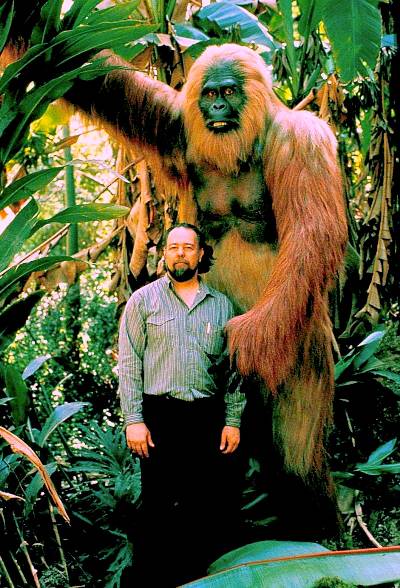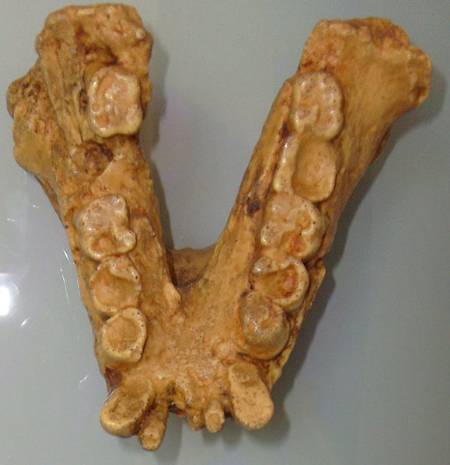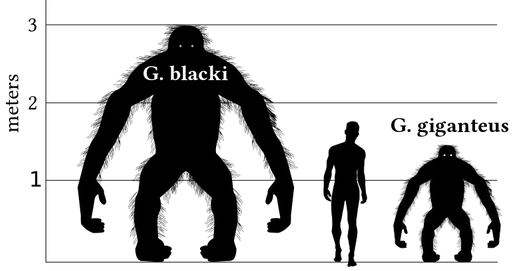Gigantopithecus
Online Biology Dictionary
|
|
 Gigantopithecus reconstruction and its creator Bill Munns
Gigantopithecus reconstruction and its creator Bill Munns
 Lower jaw. Note the unusual rounded canines. In most primates, including human beings, the canines have sharp tips.
(Image: Durova)
Lower jaw. Note the unusual rounded canines. In most primates, including human beings, the canines have sharp tips.
(Image: Durova)
 The original molar found by von Koenigswald. Image: Forschungsinstitut Senckenberg.
The original molar found by von Koenigswald. Image: Forschungsinstitut Senckenberg.

This ape, often called "Giganto," lived long ago in the jungles of southeast Asia and is now known only from fossils. But many have claimed that it still survives as the "abominable snowman" or "yeti." To the knowledge of modern science, it was the largest primate that ever lived. Huge, it weighed up to 1,200 lbs (540 kg) and stood 10 feet (~3 meters) tall.
It was first discovered in 1935 by the German-Dutch paleontologist Ralph von Koenigswald, who found a huge molar (see image below) while looking through fossil teeth in a Hong Kong pharmacy. (Chinese apothecaries have long used powdered fossils, which they call "dragon's bones," in medicines.)
Von Koenigswald named his discovery Gigantopithecus blacki. Searching additional pharmacies, he found three similar teeth and learned they had probably come from Guangxi in the far south of China. The dirt on the teeth, and the fact that their roots had been gnawed by porcupines, indicated they had come from cave deposits. Since they were found mixed with middle-Pleistocene panda and elephant fossils, von Koenigswald estimated their age at 125,000 to 700,000 years.
Von Koenigswald, who was born a German but later became a Dutch citizen, was taken prisoner by the Japanese on the island of Java during World War II. He had to hide his small collection of Giganto teeth by burying them in a milk bottle until after the war.
This ape has been described solely from fossil teeth and jaws. Modern analyses suggest that the earliest Giganto specimens are about 6.3 million years old (late Miocene); the most recent date to about 300,000 years ago. Humans (Homo erectus) arrived in the region where Gigantopithecus lived about 800,000 years ago. So the two lived together for about half a million years.
Other members of genus GigantopithecusG. giganteus Predating G. blacki by several million years and much smaller (about the same height as a human being), this ape is known from scanty remains from northern India and China. G. bilaspurensis A large ape known only from a few mandibles and teeth from India. It existed some 6 to 9 million years ago. |
The shape of its teeth, and the phytoliths embedded in them, indicate this animal had an herbivorous diet, probably including both bamboo and fruit. The molars, about an inch wide, are far larger than those of any other primate described to date. The canines differ from those of apes and humans in that they have rounded, not pointed, ends.
Additional finds have expanded the known geographic range of this bizarrely large primate outward from China to include both India and Vietnam. And recently, in 2014, fossil teeth and a mandible of G. blacki were found for the first time in Indonesia. But to date, nothing has been found except jaws and teeth. The hunt for additional remains from other, less durable portions of the body continues in the hope that we will one day have a clearer picture of this extinct(?) giant.
Back to human evolution timeline >>
 Image: Wikimedia, Discott Image: Wikimedia, Discott
|
Most shared on Macroevolution.net:
Human Origins: Are we hybrids?
On the Origins of New Forms of Life
Mammalian Hybrids
Cat-rabbit Hybrids: Fact or fiction?
Famous Biologists
Dog-cow Hybrids
Georges Cuvier: A Biography
Prothero: A Rebuttal
Branches of Biology
Dog-fox Hybrids